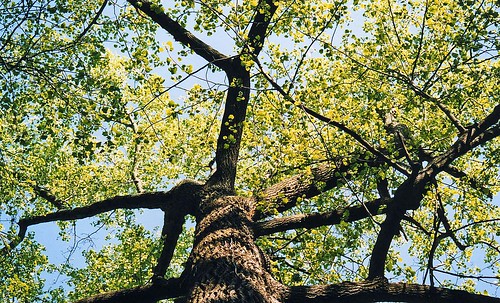
Liriodendron tulipifera
Tulip Polar
Fisher Park, Greensboro, NC
Tulip Poplar
It’s not a tulip, and it’s not a poplar, but the tulip poplar is one of our most beautiful and important trees in Guilford County. Indeed, it is quite likely that the tallest tree we have in Guilford County is a tulip poplar, as it is generally the tallest tree found in the eastern United States, and the second largest in girth after the great lowland sycamores.
Straight and tall the tulip poplar grows. The bark is light in color, furrowed more and more as the tree increases in diameter. As it grows in height it sheds quickly its lower limbs, such that in an older mature specimen, the first limbs may not appear until fifty feet up, usually stout short limbs coming off the trunk horizontally before heading upwards.
In the winter if you see a straight tall light colored tree trunk, look to the top and you will usually see at the ends of the branches the light colored petal-like stalks of the tulip poplar’s cone still hanging on from the previous fall and shining in the winter sun above the other trees.
In May, high up in the tulip tree, well after the leaves have come out for the new season, the tulip tree blooms. It’s too bad we only get to see the flowers after they fall (unless we have very good eye sight), for they are a lovely and unusual mix of green and orange, somewhat in the shape of a tulip, hence the tree’s name. These delicate flowers coat the ground under the tulip tree, and make for lots of sweeping on driveways and sidewalks.
The flower gives way to a soft cone-like structure which houses small fruits about an inch long which mature on the tree and remain until the late fall, usually being carried away by an autumn wind. Sometimes the cone will drop as a whole, but more usually it will stay on the twig over the winter, coming apart only gradually piece by piece. These light colored cone-remains, as mentioned above, are a dead giveaway for the tulip poplar in the winter. If you do see a full cone on the ground, and it reminds you of a magnolia cone, well, the tulip tree is in the same family as the magnolia.
The leaf of the tulip poplar is also very distinctive, fairly large, about five or six inches tall and wide, and also, curiously enough, shaped like a tulip flower! Think of two wide mittens, right and left, placed on top of each other with the respective thumbs sticking out, and you have the idea of the tulip poplar leaf.
The tulip poplar is one of the very first trees to begin changing colors in the fall, usually a yellow color of moderate brightness, though sometime shining forth in more brilliant array. The turning of the tulip poplar leaf is one of the first sure signs that fall is around the corner.
As a wood, tulip poplar is light in weight, almost like a pine. Useful for many building, manufacturing, storage, and packaging purposes, it was extensively logged all over the south, particularly after the railroad made getting huge pieces to the saw mills easier, and only a few stands of virgin tulip poplar remain in the state, one of them in the Joyce Kilmer Forest in Western North Carolina.
Thankfully it is a fast growing tree, so many quite large second or third growth specimens grow throughout Guilford County.
Indians as well as early pioneers made excellent canoes from the tulip poplar, given its light weight, relative strength, and ease of working. It is said that Daniel Boone and his family left Kentucky in a sixty foot long dugout canoe made from a massive tulip poplar tree. Now that’s a big canoe!




No comments:
Post a Comment